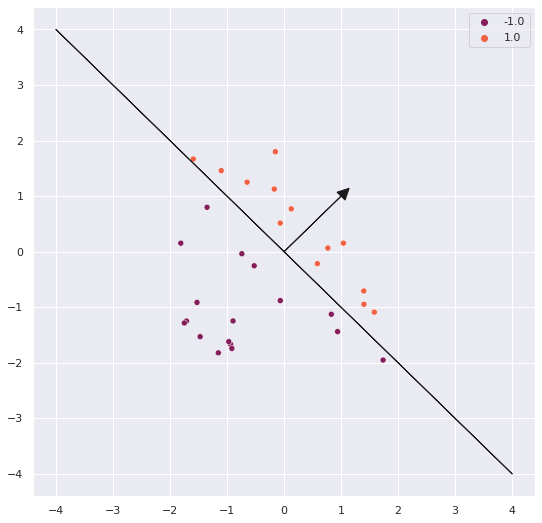Machine Translation
Contents
Machine Translation#
Imports#
import numpy as np
import scipy as sp
import matplotlib.pyplot as plt
import pandas as pd
from sklearn.decomposition import PCA
import seaborn as sns
sns.set()
Vector Manipulation#
Scaling
Translation
Rotation
R = np.array([[2, 0],
[0, -2]])
R.shape
(2, 2)
x = np.array([1, 1])
y = x@R; y
array([ 2, -2])
vectors = [x, y]; vectors
[array([1, 1]), array([ 2, -2])]
# Procedure to plot and arrows that represents vectors with pyplot
# def plot_vectors(vectors, colors=['k', 'b', 'r', 'm', 'c'], axes=None, fname='image.svg', ax=None):
# scale = 1
# scale_units = 'x'
# x_dir = []
# y_dir = []
# for i, vec in enumerate(vectors):
# x_dir.append(vec[0][0])
# y_dir.append(vec[0][1])
# if ax == None:
# fig, ax2 = plt.subplots()
# else:
# ax2 = ax
# if axes == None:
# x_axis = 2 + np.max(np.abs(x_dir))
# y_axis = 2 + np.max(np.abs(y_dir))
# else:
# x_axis = axes[0]
# y_axis = axes[1]
# ax2.axis([-x_axis, x_axis, -y_axis, y_axis])
# for i, vec in enumerate(vectors):
# ax2.arrow(0, 0, vec[0][0], vec[0][1], head_width=0.05 * x_axis, head_length=0.05 * y_axis, fc=colors[i], ec=colors[i])
# if ax == None:
# plt.show()
# fig.savefig(fname)
xaxis = 4
yaxis = 4
fig, ax = plt.subplots(); ax
colors = ['k', 'b', 'r', 'm', 'c']
ax.axis([-xaxis, xaxis, -yaxis, yaxis])
ax.arrow(0,0, x[0], x[1], head_width=0.05*xaxis, head_length=0.05*yaxis, fc=colors[0], ec=colors[0])
ax.arrow(0,0, y[0], y[1], head_width=0.05*xaxis, head_length=0.05*yaxis, fc=colors[1], ec=colors[1])
<matplotlib.patches.FancyArrow at 0x1462925a7c10>

Frobenius Norm#
A = np.array([[2,2], [2,2]])
np.linalg.norm(A)
4.0
np.sqrt(np.sum(np.square(A)))
4.0
Basic Hashing#
x = np.random.randint(1,100,20)
x
array([63, 18, 16, 14, 88, 96, 76, 3, 35, 64, 43, 19, 37, 8, 74, 24, 21,
75, 26, 57])
def hash_function(val, n_buckets=10):
return val%n_buckets
def basic_hashing(values, n_buckets=10, hf=hash_function):
hash_table = {b:[] for b in range(n_buckets)}
for val in values:
b = hf(val, n_buckets)
hash_table[b].append(val)
return hash_table
basic_hashing(x)
{0: [],
1: [21],
2: [],
3: [63, 3, 43],
4: [14, 64, 74, 24],
5: [35, 75],
6: [16, 96, 76, 26],
7: [37, 57],
8: [18, 88, 8],
9: [19]}
i = 40
hash_function(i, n_buckets=10)
0
Locality Sensitive Hashing#
Need: Hashing function that is sensitive to location of items it’s assigning into the buckets
Reduces computational cost of finding k-nearest neighbours in high dimensional spaces
Hash tables - Data structures based on dictionary. That allows to index data in order to improve heavy look up tasks.
a = np.array([1,2,-3])
np.sign(a)
array([ 1, 1, -1])
a = np.array([[1]])
# np.asscalar(a) -> Depreciated
a.item()
1
P = np.array([1,1]); P
rot = np.array([[0, 1], [-1, 0]])
PT = P@rot
print(PT)
v = np.array([np.random.uniform(-2,2,2) for i in range(30)])
side_of_plane = np.sign(P@v.T)
x = v[:,0]
y = v[:,1]
fig, ax = plt.subplots(figsize=(9, 9))
sns.scatterplot(x=x, y=y, hue=side_of_plane,palette=sns.color_palette("rocket", 2), ax=ax)
xaxis = 4
yaxis = 4
colors = ['k', 'b', 'r', 'm', 'c']
ax.arrow(0,0, P[0], P[1], head_width=0.05*xaxis, head_length=0.05*yaxis, fc=colors[0], ec=colors[0])
ax.arrow(0,0, PT[0]*4, PT[1]*4, fc=colors[0], ec=colors[0])
ax.arrow(0,0, PT[0]*-4, PT[1]*-4, fc=colors[0], ec=colors[0])
[-1 1]
<matplotlib.patches.FancyArrow at 0x1462916026d0>

Multi Plan Hash function#
P1 = np.array([[1, 1]]) # First plane 2D
P2 = np.array([[-1, 1]]) # Second plane 2D
P3 = np.array([[-1, -1]]) # Third plane 2D
P_l = np.array([P1, P2, P3]) # List of arrays. It is the multi plane
# Vector to search
v = np.array([[2, 2]])
side_of_plane=(np.sign(P_l@v.T).ravel() >=0)*1
array([1, 2, 4])
def hash_multi_planes(P_l:np.array, v:np.array):
side_of_plane=(np.sign(P_l@v.T).ravel() >=0)*1
return 2**np.arange(0,len(P_l),1)@side_of_plane.T
hash_multi_planes(P_l, v)
3
np.random.seed(0)
num_dimensions = 2 # is 300 in assignment
num_planes = 3 # is 10 in assignment
random_planes_matrix = np.random.normal(
size=(num_planes,
num_dimensions))
print(random_planes_matrix)
[[ 1.76405235 0.40015721]
[ 0.97873798 2.2408932 ]
[ 1.86755799 -0.97727788]]
hash_multi_planes(random_planes_matrix, v)
7
np.linalg.norm(np.array([[1, 3],[4, 5]]))
7.14142842854285


